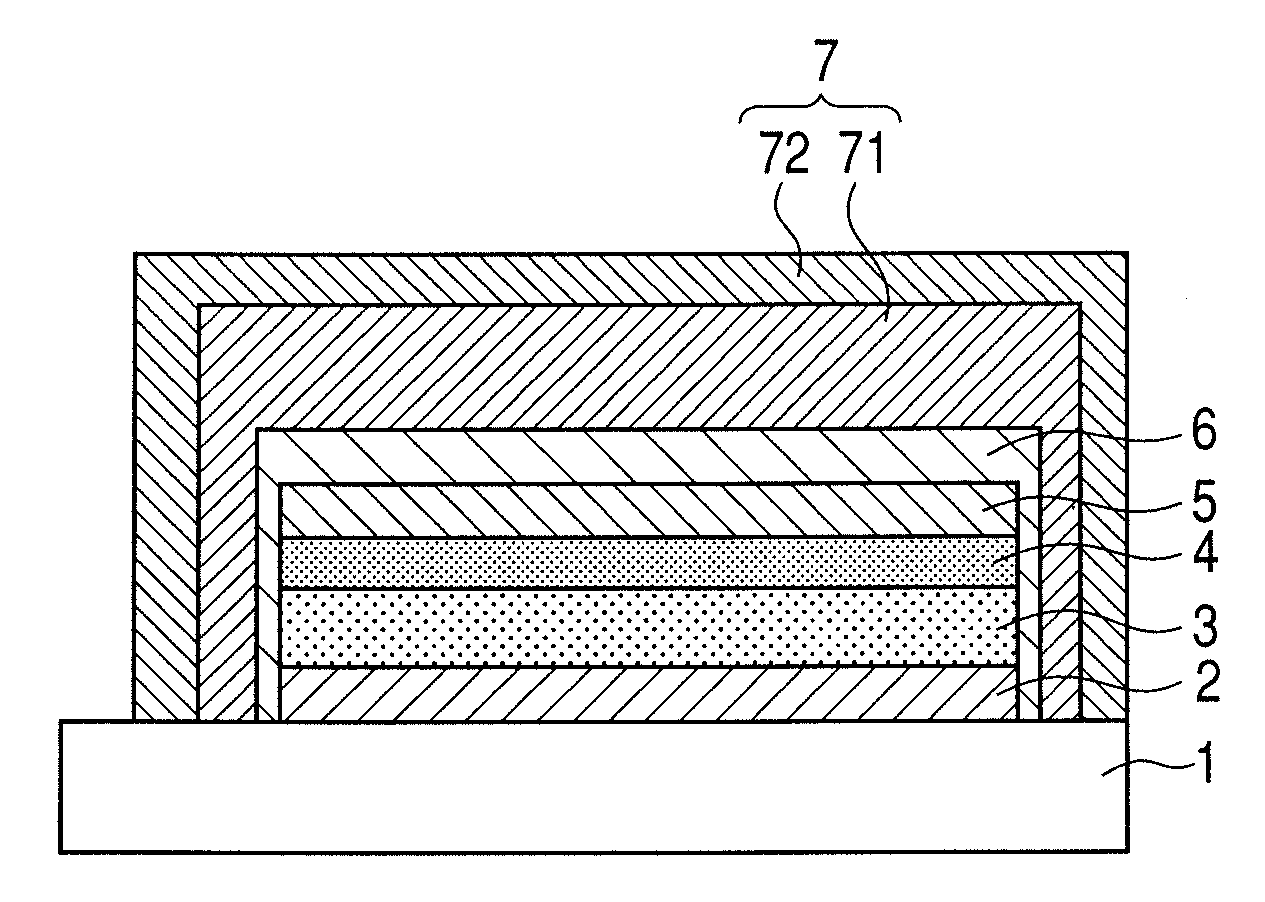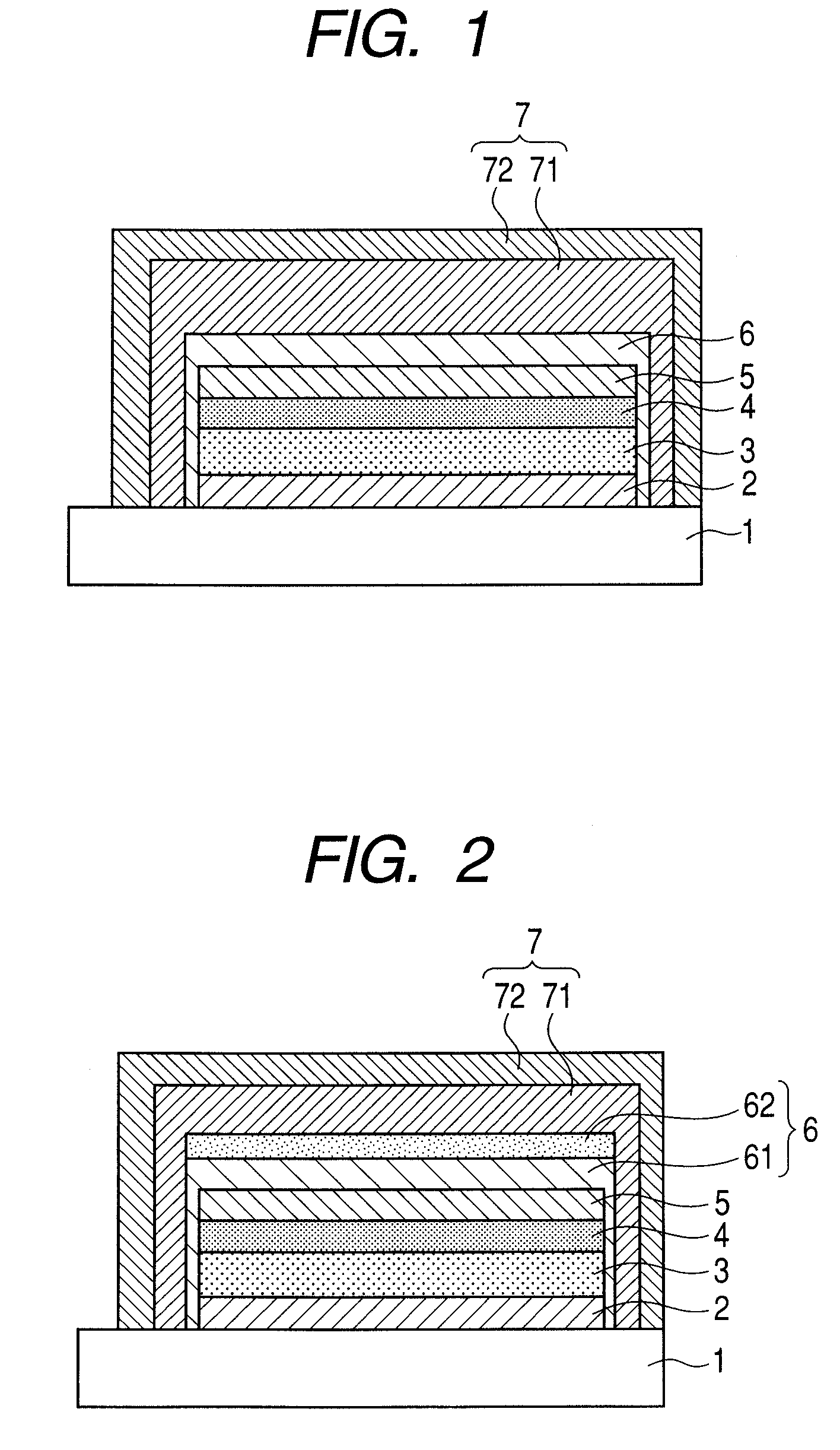Organic el device and method of producing the device
a technology of organic el and electrodes, which is applied in the manufacture of electrode systems, electric discharge tubes/lamps, and discharge tubes luminescent screens, etc., can solve the problems of affecting the el device's el performance, affecting the el performance, so as to prevent the infiltration of moisture or oxygen into the organic compound layer of the organic el devi
- Summary
- Abstract
- Description
- Claims
- Application Information
AI Technical Summary
Benefits of technology
Problems solved by technology
Method used
Image
Examples
example 1
[0051]The generation of voids in the organic EL device of the present invention shown in FIG. 1 is evaluated.
[0052]The substrate 1 having a constitution shown in FIG. 1 is formed by stacking a TFT, an insulating film, and an organic planarization film (none of which is shown) in the stated order on a glass substrate. The lower electrode 2 formed of chromium is formed on the substrate, and furthermore, the periphery of the electrode is insulated with a device isolation film formed of polyimide (not shown).
[0053]First, the above substrate 1 was baked in a vacuum baking furnace at 200° C. for 4 hours. After that, the pressure in the vacuum baking furnace was returned to atmospheric pressure, and the substrate was taken out of the vacuum baking furnace and conveyed. Next, the substrate was placed in a baking chamber. The chamber was evacuated to a degree of vacuum of 1×10−4 Pa, and the substrate was baked at 150° C. for 10 minutes. The substrate 1 was conveyed to a UV chamber. The press...
example 2
[0064]In Example 2, an organic EL device shown in FIG. 1 was produced while silicon oxide was used in the first passivation layer 6 and the thickness of the first passivation layer 6 was changed.
[0065]The same substrate as that of Example 1 was used, and a process commencing on vacuum baking to ending on the formation of the upper electrode was the same as that of Example 1.
[0066]The substrate was conveyed to another sputtering chamber, and silicon oxide was formed into a film having on the substrate with a DC sputtering method while oxygen and an argon gas were flowed and the pressure at which the film was formed was adjusted to 0.8 Pa, whereby the first passivation layer 6 was obtained.
[0067]The second passivation layer 7 was formed in the same manner as in Example 1.
[0068]The above process was repeated so that three organic EL devices in each of which the thickness of the first passivation layer 6 was 50 nm, three organic EL devices in each of which the thickness of the layer was...
example 3
[0079]In Example 3, an organic EL device shown in FIG. 2 was produced while silicon oxide was used in the first layer 61 of the first passivation layer 6, silicon nitride was used in the second layer 62 of the layer, and the thickness of each of the first and second layers was changed.
[0080]The same substrate 1 as that of Example 1 was used, and a process commencing on vacuum baking to ending on the formation of the upper electrode 2 was the same as that of Example 1.
[0081]The substrate 1 was conveyed to another sputtering chamber, and silicon oxide was formed into a film on the substrate with a DC sputtering method by using a target formed of silicon while oxygen and an argon gas were flowed and the pressure at which the film was formed was adjusted to 0.8 Pa, whereby the first layer 61 of the first passivation layer 6 was obtained.
[0082]The substrate 1 was conveyed to another sputtering chamber, and silicon nitride was formed into a film on the substrate with a DC sputtering metho...
PUM
| Property | Measurement | Unit |
|---|---|---|
| thickness | aaaaa | aaaaa |
| thickness | aaaaa | aaaaa |
| thickness | aaaaa | aaaaa |
Abstract
Description
Claims
Application Information
 Login to View More
Login to View More - R&D
- Intellectual Property
- Life Sciences
- Materials
- Tech Scout
- Unparalleled Data Quality
- Higher Quality Content
- 60% Fewer Hallucinations
Browse by: Latest US Patents, China's latest patents, Technical Efficacy Thesaurus, Application Domain, Technology Topic, Popular Technical Reports.
© 2025 PatSnap. All rights reserved.Legal|Privacy policy|Modern Slavery Act Transparency Statement|Sitemap|About US| Contact US: help@patsnap.com



